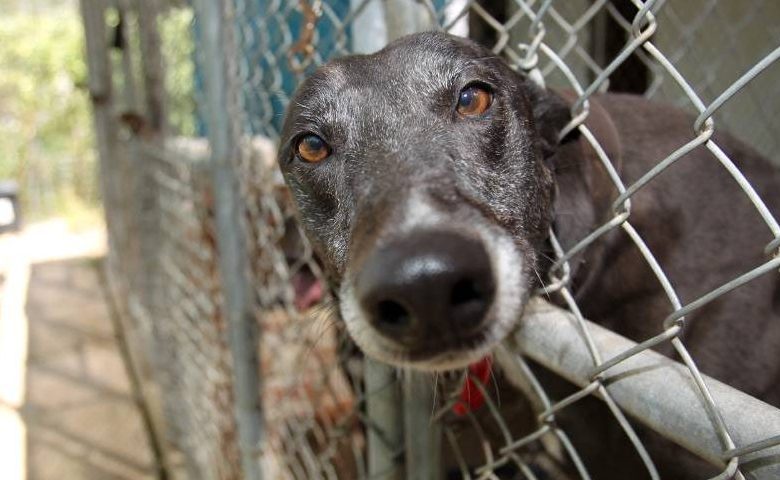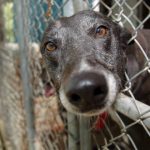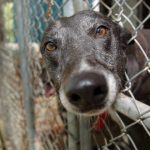Please remember that your dog must be microchipped and always have an identification tag.
When you let him out into the garden off the lead the first few times, pop his muzzle on. This will give local cats and wildlife a chance to register that a fast dog has moved in. Even if your dog is cat friendly, he will regard other visiting cats in his garden as easy game.
When you walk him in public, be aware if he may be required to be muzzled according to council laws in your area. Remember, he may have recently come from the race track, where he has learned that chasing small furry things with a view to killing is the right thing to do. It will take him some time to learn that you want a different response. If people you meet seem frightened by the fact that he is wearing a muzzle, do take time to explain that he is not a dangerous dog but that you are a responsible dog owner with a rescue dog.
Please note that many councils throughout Australia are removing the muzzling laws. As a responsible owner, we recommend you contact your local council to ascertain the current requirements in your specific area.
Never let a child hold the lead without supervision. These dogs can have huge power and acceleration; they could, on seeing a cat, rush onto the road dragging your child into danger.
Please spend time teaching your dog recall. He may never have learned his name. He will never have been off the lead except on the racetrack. However good his recall is at home, when he is out and he sees small animals running, there is a strong possibility he will forget all that he has learned. So, it will be some time before you will be able to let him off the lead. When you finally feel he is ready to be let off the lead, find a safe, enclosed space where you can do it. Keep his muzzle on in case someone’s cat should wander across his path. Have treats ready. He will be very fast, and it is very scary to see the speed with which these dogs can disappear into the distance. So if in doubt – do not let him off. When he returns, give him a treat and let him mooch off again, otherwise he will soon learn not to come back if it means being put on the lead straight away.
We are not great advocates of dog parks, as too many things can go wrong for your dog. We believe “bad things happen to good dogs” in a dog park. Examples of situations we have heard about time and again are:
- Uneven surfaces, dog agility platforms and jumps, together with holes dug into the ground by other dogs, can all present a very real danger to your greyhound when he is running at top speed around a dog park.
- Muzzling your greyhound in a dog park can leave him vulnerable to attacks by other dogs – he will be unable to defend himself.
- Your greyhound may be best friends with your small fluffy dog while inside your home and in your backyard, but other small fluffy dogs running around a dog park can sometimes be far too tempting – often leading your greyhound to become more “serious” about the chase, followed by panic from small dogs and their owners.
If you do want to exercise your dog in a dog park, we recommend doing so outside of popular hours when the park is not being utilised by others.
We do not recommend greyhounds ever being off lead outside fenced locations – it is highly dangerous to the safety of your dog, along with other animals. However, if you do decide to take this approach, much time is required to rehabilitate ex-racing greyhounds to be safe off the lead, so patience is required. Do not worry if your dog is only getting lead walks. This is what they are used to. The world outside kennels is a big scary place and they feel safer on a lead beside you. They are sprint dogs and do not need lots of exercise. Their favourite pastime is sleeping on a nice soft bed.
Please arrange pet insurance for your dog. He may get ill or injured, and you could be suddenly faced with huge vet bills. He could also cause an accident, and therefore liability insurance is essential.
Never leave your dog tied up outside a shop or unattended in your garden. Your dog could be crowded by strangers or tied up next to a dog resulting in anxiety for your grey, up to bites, or even them breaking free and running away. It sounds melodramatic, but it does occur.
Bedding
Your greyhound will like a soft thick bed, such as an old doona. They like to stretch out, so they sometimes find basket-type beds too constricting. They will make a beeline for the sofa, so if you do not want them to use it, you will need to set some ground rules early. Putting obstacles on the sofa when you are not in the room will often help.
Teeth
Due to only being fed soft foods in the industry, greyhounds over two years old generally have dental disease, which is why tooth brushing and maintenance is an important part of owning a greyhound. Chews will help to keep teeth healthy, and we recommend you use special dog toothpaste and gently brush his teeth clean. Do not use human toothpaste.
Fleas
Fleas can be difficult to shift if a dog has had a large infestation, so do keep re-checking and make sure you use a reputable company’s flea tablet. We do not recommend topical flea treatments as there have been instances of greyhounds fitting.
Feet
Greyhound claws need regular trimming. If this is neglected, the dog will walk awkwardly, causing further problems. It is best to let your vet do it at first while you watch before attempting to do it yourself. As with all dogs, Greyhounds should not be walked on bitumen, sand or concrete on excessively hot days in Australia, as their pads can be scorched. If the ground is too hot for you to walk on bare-foot, then it is also too hot for your dog.
Collars
Your dog should wear a Martingale collar, which is specifically made with Greyhounds in mind, rather than a flat collar. Greyhounds have tapered necks and tiny ears so a loose collar can easily slip over their heads which may be dangerous when out on a walk. Make sure that the collar is adjusted whilst it is at the top of the neck and cannot slide off. If the leash is being pulled tight, we strongly recommend using a harness. A tight collar is painful and can damage the sensitive neck of your greyhound.
Harnesses: We recommend H-type harnesses that clip on the dog’s back. Front clipping harnesses can impede gait. Ensure the harness you choose does not impede movement, and look for a low-friction harness. You can get a lead that will clip to both the collar and harness for extra security.
Injuries
Your dog may have been retired from racing through injury. The centrifugal forces of the sharp bends on a track put enormous strain on the dog’s joints and toes. Injury may be caused by falling or colliding with other dogs at speed. This will not always be obvious, but just like us, your dog may become prone to arthritis later on.
Coat/Skin
Greyhounds often come out of racing kennels with their coats patchy and scurfy. You will find that once in a home, they will lose this kennel coat and a beautiful shiny, sleek coat will appear. Grooming and good feeding (see Fact Sheet 3 “Feeding Your Dog”) will help speed this process up.
There is much conjecture in relation to the hair loss that appears around a greyhound’s rump, flank and back of legs. Schools of thought in relation to hair loss include mites, skin bacteria, thyroid conditions and living on concrete floors while in trainers’ kennels. Some dogs will remain this way for years, whereas others will have hair return after several months in your care. We recommend you discuss this with your vet.
Worming
Please remember to worm your dog regularly. A vet will best advise you on a suitable product.
Heartworm
We recommend you discuss with your vet in relation to whether you provide monthly tablets and an annual injection. Either way, preventative treatment for this disease is an important consideration when owning a greyhound (or any dog for that matter).
Vaccinations
The Australian Veterinary Association has a position statement on vaccines here that recommends vaccination boosters as frequently as considered necessary by their veterinarian to provide protection. The 2015 World Small Animal Veterinary Association (WSAVA) guidelines suggest a triennial core vaccination schedule (every 3 years for C5 and a personalised non-core vaccination schedule (for example, kennel cough).
It is important to note that if you live in a high-risk area, it may be safest to vaccinate yearly.
Last modified: November 18, 2023




